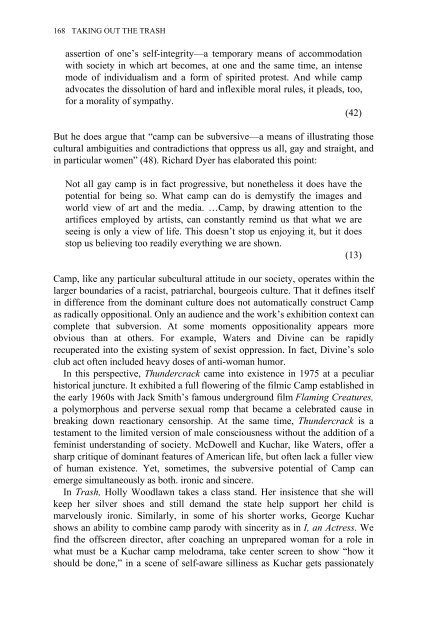Edited by Moe Meyer - Get a Free Blog
Edited by Moe Meyer - Get a Free Blog
Edited by Moe Meyer - Get a Free Blog
You also want an ePaper? Increase the reach of your titles
YUMPU automatically turns print PDFs into web optimized ePapers that Google loves.
168 TAKING OUT THE TRASH<br />
assertion of one’s self-integrity—a temporary means of accommodation<br />
with society in which art becomes, at one and the same time, an intense<br />
mode of individualism and a form of spirited protest. And while camp<br />
advocates the dissolution of hard and inflexible moral rules, it pleads, too,<br />
for a morality of sympathy.<br />
(42)<br />
But he does argue that “camp can be subversive—a means of illustrating those<br />
cultural ambiguities and contradictions that oppress us all, gay and straight, and<br />
in particular women” (48). Richard Dyer has elaborated this point:<br />
Not all gay camp is in fact progressive, but nonetheless it does have the<br />
potential for being so. What camp can do is demystify the images and<br />
world view of art and the media. …Camp, <strong>by</strong> drawing attention to the<br />
artifices employed <strong>by</strong> artists, can constantly remind us that what we are<br />
seeing is only a view of life. This doesn’t stop us enjoying it, but it does<br />
stop us believing too readily everything we are shown.<br />
(13)<br />
Camp, like any particular subcultural attitude in our society, operates within the<br />
larger boundaries of a racist, patriarchal, bourgeois culture. That it defines itself<br />
in difference from the dominant culture does not automatically construct Camp<br />
as radically oppositional. Only an audience and the work’s exhibition context can<br />
complete that subversion. At some moments oppositionality appears more<br />
obvious than at others. For example, Waters and Divine can be rapidly<br />
recuperated into the existing system of sexist oppression. In fact, Divine’s solo<br />
club act often included heavy doses of anti-woman humor.<br />
In this perspective, Thundercrack came into existence in 1975 at a peculiar<br />
historical juncture. It exhibited a full flowering of the filmic Camp established in<br />
the early 1960s with Jack Smith’s famous underground film Flaming Creatures,<br />
a polymorphous and perverse sexual romp that became a celebrated cause in<br />
breaking down reactionary censorship. At the same time, Thundercrack is a<br />
testament to the limited version of male consciousness without the addition of a<br />
feminist understanding of society. McDowell and Kuchar, like Waters, offer a<br />
sharp critique of dominant features of American life, but often lack a fuller view<br />
of human existence. Yet, sometimes, the subversive potential of Camp can<br />
emerge simultaneously as both. ironic and sincere.<br />
In Trash, Holly Woodlawn takes a class stand. Her insistence that she will<br />
keep her silver shoes and still demand the state help support her child is<br />
marvelously ironic. Similarly, in some of his shorter works, George Kuchar<br />
shows an ability to combine camp parody with sincerity as in I, an Actress. We<br />
find the offscreen director, after coaching an unprepared woman for a role in<br />
what must be a Kuchar camp melodrama, take center screen to show “how it<br />
should be done,” in a scene of self-aware silliness as Kuchar gets passionately


